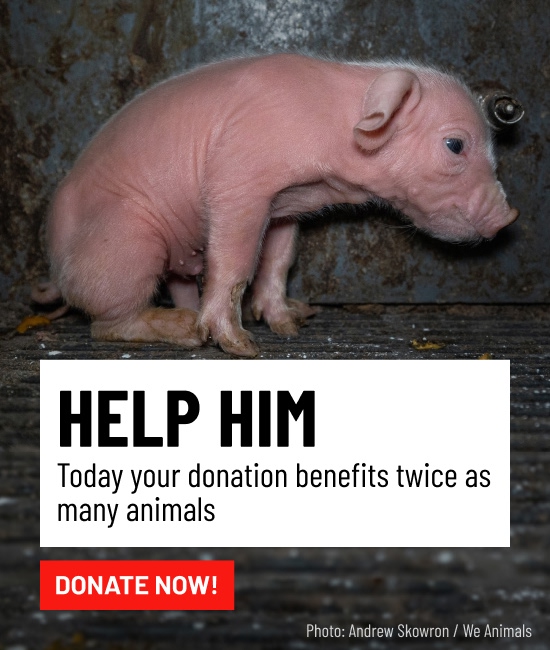8 Years of Investigations in Asia
The Threat of Wet Markets, China, India, and Vietnam, 2020
In April 2020, in response to the pandemic caused by COVID-19, Animal Equality released a new investigation with footage collected in wet markets that sell live animals in China, India, and Vietnam. As we’ve detailed, these markets are hell on earth for animals because in these places there aren’t laws that protect them from torture and abuse.
Wet markets are also a threat to global public health. In these markets, wild and farmed animals live together in cramped, unsanitary cages. The stress from their transport and living conditions cause their immune systems to weaken, creating the perfect breeding ground for zoonotic viruses to make the jump from animals to humans.
This was the case with SARS (Severe Acute Respiratory Syndrome), as well as COVID-19, which many scientists believe originated in a wet market.
Along with our investigation, we launched a petition asking the United Nations (UN) to ban wet markets worldwide. So far, the petition has already collected over half a million signatures.
As a response to the outbreak, the Chinese government announced a ban on wild animal trade and consumption and directed the closure of certain illegal markets. In May, our undercover investigators went to see for themselves if the markets had indeed been shut down, as was reported by the media and government.
The footage we obtained speaks for itself.
Chicken Markets, India, 2017 – 2018
In 2017, Animal Equality India extensively documented the cruelty of the chicken meat industry. For six months, our team investigated chicken farms and markets in the cities of Pune, Raigad, and Delhi.
We filmed the terrible conditions of breeding, transport, and slaughter to which these fragile animals are subjected. In Indian live animal markets, chickens are kept in tiny cages for days without food or water. They are then slaughtered by having their throats cut and being left to die in agony.
According to Indian food safety standards, chickens should be killed in authorised slaughterhouses and stunned before they are slaughtered. However, these standards are systematically violated in many cases.
Despite India having a high population of vegetarians, chicken meat consumption has been increasing in recent years due to political pressure and lobbying by large European corporations which are working to expand their product sales into new territories.
Animal Sacrifice at the Gadhimai Festival, Nepal, 2014 – 2019
Every five years, Nepal hosts the Gadhimai festival which involves the killing of thousands of animals.
Considered the biggest sacrifice of animals in the world, large numbers of buffaloes, goats, sheep, and birds are brutally slaughtered. For over half a decade, Animal Equality investigators have been at the forefront of the effort to stop this cruel massacre.
In 2014, we launched a campaign to ban animal sacrifice in Nepal, asking the temple to hold alternative rituals that would not involve killing or mistreating animals.
Following relentless campaigning by Animal Equality India, the neighbouring government of India adopted a new policy that stopped the transportation of animals into Nepal during the Gadhimai festival. This decision was vital in reducing the number of animals sacrificed, with 70% fewer animals sacrificed in the 2014 festival than in 2009.
Unfortunately, despite protests from across the world, the festival took place as scheduled in 2019. For this reason, our campaign to end animal sacrifice in Nepal continued and our investigators were again on the ground to document the massacre.
In an effort to redirect festival attendees from sacrificing animals, we worked in collaboration with the Red Cross in Nepal to organise stations where devotees could donate blood (instead of the blood of animals) to pay homage.
The Dog and Cat Meat Trade, China, 2012 – 2015
Every year, more than 10 million dogs are slaughtered for their meat and skin. Though numerous, there is still no official estimate for the number of cats killed.
Since 2012, Animal Equality has been investigating this cruel trade, releasing a series of poignant investigations that have shocked the public.
The stories we have collected are astounding.
This first video is an intense investigation into slaughterhouses and dog meat markets.
Our investigators travelled throughout the region and with the help of brave local activists, covertly infiltrated the criminal groups that were trafficking dogs around the country.
Our team captured these images in illegal slaughterhouses, where dogs were beaten, dragged, and treated like objects. They’re confined to dark rooms where they live amongst their own waste and watch helplessly as their companions are slaughtered.
In two facilities our investigators documented the killing of dogs. The animals are first stunned by repeated blows to their heads and then their throats are cut.
These are terrible scenes which are impossible to forget.
Dog flesh is sold for consumption in markets, while their skins are used to make coats, toys, and bags.
At one market, Animal Equality investigators found that traders sell carpets made of cat and dog fur, some of which are made from the remains of nine or more animals.
The images obtained by our investigators have been seen by people around the world and thanks to the outcry from our footage and assistance from the Volunteer Centre of Guangzhou, 33 markets and an illegal dog and cat slaughterhouse were closed by the authorities.
Thanks to our close collaboration with dedicated Chinese activists and law enforcement agencies, about 600 dogs and cats were rescued.
Here is the story of one of those animals, a dog named Vita who was saved from an illegal slaughterhouse by our investigators:

